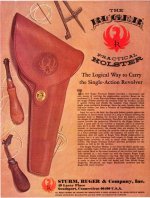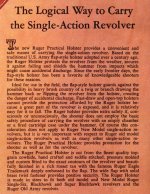I actually stuffed a $1 bill (I'm cheap) in the cylinder of a Colt SAA once, then fired a blackpowder load in the chamber next to it. All I can say is that anyone who carried money in the cylinder of a Colt 45 didn't carry it very long. That blackpowder load burned my $1 to a crisp. There were a few singed pieces of it left, but it was essentially ruined by a single shot.
As an aside, and I don't want to drift the thread here, that 1878 Ordnance Memorandum I mentioned above also specified the Colt 45 load as 28 grains of black powder and a 230 grain ball. I'm thinking that was loaded in the shorter 45 Schofield case as another manual notes the load was reduced to work in the Schofield. I knew they had reduced the powder charge to 28 grains but didn't know the bullet weight was also reduced. Sheesh! What a powderpuff! 40 grains of black in a Colt 45 case has some real power, but I'm going to have to load a few of these and see what the chronograph tells me. Bet it isn't much over 750 fps, if that.
The Jan. 12, 1876 edition of the Wichita Beacon had the following on an incident noted above involving Wyatt Earp:
“Last Sunday night, while policeman Earp was sitting with two or three others in the back room of the Custom House Saloon, his revolver slipped from its holster, and falling to the floor, the hammer which was resting on the cap, is supposed to have struck the chair, causing a discharge of one of the barrels (sic). The ball passed through his coat, struck the north wall then glanced off and passed out through the ceiling. It was a narrow escape and the occurrence got up a lively stampede from the room. One of the demoralized was under the impression that someone had fired through the window from the outside.”
I suppose Earp might have carried 5 after that, but he apparently wasn't aware of the potential problem in Jan., 1876. I'm still looking for something of the time that says one should carry only 5 rounds. Haven't found it yet.
That was not the .45 Schofield nor the .45 Colt. It was the .45 Government. The original 40 gr load was deemed too powerfull (recoil wise) to inexperienced mounted troops, I think there were a lot of cases of men falling from their horses after touching one round.
One thing I know. Having loaded the similar .44WCF with 35 gr FFFg(there was no room for 40 gr on a modern case without compressing), I found the recoil equivalent to a full house .44 Mag fired from a 6" model 29.
Edit. And it made an impressive 1100 fps out of a 5 1/5 barrel (Uberti Cattleman SAA replica BP frame).
Last edited:




